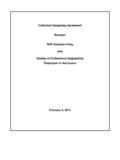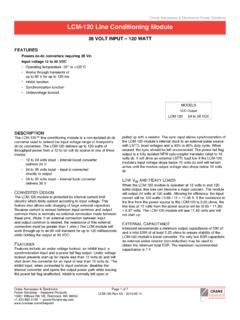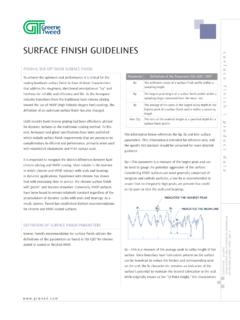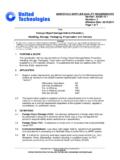Transcription of Challenge in Aerospace Leadership - SPEEA Website
1 1 Challenge in Aerospace LeadershipNeeded: A Strategy that Makes Sense for all Boeing Stakeholders Stan Sorscher, THESISB oeing s globalization strategy is designed to optimize short-term financial performance. This favors the interests of financial stakeholders, but it makes lesssense to Boeing s technical community. We identify several areas of practical concern, and explain how each factor threatens our ability to compete effectivelyin the long-term. Finally, we offer a roadmap for constructing a plan that makessense to all stakeholders. I. Overview Shift in Business StrategyFor decades, Boeing maintained competitive advantage through technical per-formance of advanced Aerospace products.
2 Over the last 5 years, business strategyhas shifted steadily in favor of financial performance through cost-cutting, shed-ding of assets, and increasing reliance onglobal suppliers. Our new goals are lowerunit costs for labor and capacity, leadingto higher short-term margins. As a consequence, we experience a frag-menting technical and manufacturing community; weakened flow of information;loss of accumulated knowledge, skills and experience; and diffusion of controland authority needed to manage current and future programs. Boeing s technical community recognizes a serious risk that cost-cutting and pur-suit of short-term financial performance will compromise our ability to competeeffectively in the Boeing shifts direction, we are losing the essential functions of the integrated technical community without recreating them in the global network.
3 Boeing stechnical community challenges all stakeholders: Build a plan that makes sense toall of us. We seek a coherent strategy that balances the long-term interests of employees,customers, suppliers, long-term investors and the public, with the short-term inter-ests of financial Industry CharacteristicsAny successful out-sourcing strategy must match the particular characteristics ofthe industry involved. In Boeing s case, at least 7 features must be factored intoany successful out-sourcing strategy: Heavily engineered complex products, requiring coordination and communi-cation in design, manufacture and operation.
4 Vulnerability to s technical community recognizes a seriousrisk that cost-cutting and pursuit of short-termfinancial performance will compromise our abilityto compete effectively in the Business Critique Very long production and operational cycles, atrelatively low production rates. Unfavorable population dynamics aging andshrinking technical community. Dramatic learning curves. Critical mass of experience and first-hand connection to products. Trust and confidenceof our customers, public and , these factors interact and overlap. Our Challenge is to account for thesecharacteristics in a coherent Risk FactorsConcerns heard in the workplace can be expressed in four categories: Steady out-sourcing of design, manufacturing, and service functions hasweakened the infrastructure and flow of informationwe relied on fordecades of market success.
5 Population dynamics have reached an alarming condition, where knowledgeskills and experience are depleted by layoffs, voluntary quits and retirements. Accounting limitations create biasin our decision-making. Confidence, trust and the sense of common interest are at historic Weakened Infrastructure Commodity or Community?Out-sourcing strategies focus on products that are commodities, for the most daily experience convinces us that our design and manufacturingenvironment operates largely as a OF WORKPLACE EXPERIENCESA few illustrations would be useful in illustrating our range of concern. The highlighted portions at the bottom of followingpages contain composite situations derived from numerous workplace experiences.
6 They are representative, but not do notnecessarily correspond to real events. CASE 1. AIRPLANE SYSTEM CONFLICT,Illustrating: Sub-optimization Complex products Confidence of customers and publicDuring initial flight test for a new model of airplane, we realize that the navigation system and flight management systeminterfere with each other. As system integrator, we go to the Nav designer who says, We agree that I met spec and while Isympathize, I can only wish you the best of luck. We go to the flight management design team, and say, We believe yourunit generates a runt pulse under rare conditions which interferes with the nav system.
7 The flight management team leadersays, We met spec, too, with or without a runt pulse. You might want your lawyers talk to our lawyers. We ask, Can youtell us where the runt pulse comes from, and what our options are for dealing with it? The vendor replies, This unit con-tains proprietary components. It is part of our competitive advantage - we would like to sell this to Gulfstream and severalother customers. Good luck, though. Imagine the same situation, except the interference is discovered during a crash investigation, with a minimum $150 millionliability to be divided among the responsible parties.
8 The sub-optimization will probably become more the same situation, but now the FAA is considering grounding the fleet while the problem is analyzed and a solutionis verified. For reference, the DC-10 fleet was grounded for several weeks after the crash in Chicago. The Concorde fleet was grounded formonths after the recent crash. Airline and government customers can ground their fleets for various service and performance reasons. 2 In Boeing s case, at least 7 featuresmust be factored into any successfulout-sourcing strategyEngineer s View of Out-sourcingFigure 1suggests how out-sourcing might fit strategically into a larger picture, asseen from the perspective of the engineering community.
9 The primary drivinggear is the worldview. It will be the source of the market strategy, which will thendetermine the customers. From the engineer s point of view, the key gears involveproducts and processes. One message we hear is that Boeing sfuture centers on system integration,project management and supplychain management. We are told wewill develop new markets, and main-tain the technical and business sys-tems that define how we build air-planes. In this vision, our suppliersand global partners will be responsi-ble for most of the design and manu-facturing, while we will write specifi-cations and handle sales, marketing,final assembly, and that case, the supplier network will take up much of the technical activity in theupper-right set of wheels.
10 Process improvement, and much of the research anddevelopment would probably also move to the suppliers. Boeing might direct orinitiate and possibly finance new ideas in production, butthe suppliers would control technical prospect creates widespread concern in the engi-neering community. Our new direction lacks a practicalorganizational structure for managing the critical flow ofknowledge and experience between R&D, design, manu-facturing and customer service. In our previous organiza-tional structure, we used a well-knit and strong networkof relationships for the flow of information. E-mail and computer network links tosuppliers will not substitute for the existing organizational and social Integration and Project ManagementBoeing claims system integration as a core competency.










